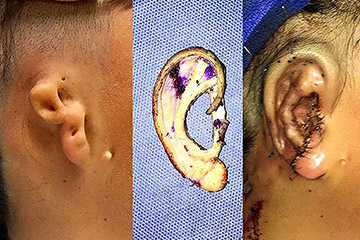New York Center for Facial Plastic Surgery
Schedule a consultation

Information About Microtia Ear Surgery in New York, NY with Dr. Andrew Jacono.

Microtia is a congenital ear deformity that occurs in 1 in 5,000-7,000 births. It results in non-formed or misshapen ears. In different countries, and among different ethnicities, the rate of incidence may be even higher.
“Microtia” is a Latin-based term. “Micro” means small, and “otia” means ear. Typical microtia—grade 3—looks like a small, sausage-shaped wrinkle of skin. Grade 2 microtia is less severe and often looks like a miniature ear. Grade 1 microtia is a minimally deformed ear.
90% of the time, only one ear is affected by microtia, though in some cases, both ears are deformed. Interestingly, there are twice as many right-sided cases as left, and affects boys 65% of the time.
Microtia usually develops during the first trimester of pregnancy. The cause is largely unknown but has been linked to genetic conditions, environmental triggers, drug and alcohol use during pregnancy, and a low-carbohydrate diet. Geography Microtia’s severity varies from patient to patient.
Another possible risk factor for microtia is diabetes. If the mother is diabetic before pregnancy, she is at a higher risk of giving birth to a baby with microtia.
Traditionally, there are two primary methods of repairing microtia. Each uses different material to construct the framework of the ear. One method uses a living sculpture constructed from the patient’s own tissue (usually rib cartilage). The other technique uses a firm artificial plastic.
Dr. Jacono prefers to use rib cartilage, as it comes from the patient’s own body. He believes that synthetic foreign material has a higher risk of causing infection and extrusion.
Dr. Jacono will repair microtia after patients are 6 years of age. Surgery cannot be performed earlier, as the rib cartilage used to reconstruct the ear needs to be large and sturdy enough to carve and insert.
Microtia reconstruction is performed over a series of 3 to 4 operations. These operations are spread out over the course of a year. Because this surgery is usually performed when the patient is young, the procedure is done under general anesthesia.
The first microtia procedure involves harvesting cartilage from the child’s ribcage and carving it into the framework of an ear. This framework is then implanted into its final site. Subsequent procedures involve small alterations to the ear, including ear lateralization and the creation of an ear lobule. The first procedure usually requires a 3–4-night hospital stay. All subsequent procedures are performed on an outpatient basis.
New York Center for Facial Plastic Surgery
Schedule a consultation

Usually, recovery from microtia surgery is short. Patients are able to return to light activity after about 3 days of recovery and can attend to their usual business after 3 weeks.
Most patients have pain in the chest donor site for a few days after their first procedure. Additionally, they may feel groggy for some time due to the use of a general anesthetic. Dr. Jacono usually places drainage tubes in the chest area but removes them after a few days.
Second and third surgeries have a recovery time of 3 to 6 weeks. Once the ear has been fully reconstructed and the grafts have healed, patients can return to all of their normal daily activities, including sports.
Dr. Jacono regularly visits South America for medical microtia missions. On these trips, he performs surgery on dozens of patients who were born without one ear or, in some cases, without both ears.
Dr. Jacono volunteers for a number of nonprofit organizations, including Healing the Children and the H.U.G.S. (Help Us Give Smiles) Foundation. Over the years, he has operated on hundreds of children without proper access to medical care.

This boy was born with grade 3 microtia and had very little natural ear cartilage. Dr. Jacono harvested tissue from the patient’s ribs, which he then carved into the shape of an ear. He placed this cartilaginous framework on the patient’s head. The boy now has a natural-looking ear, which will only look better with further surgery.

This patient was born with grade 3 microtia. He had very little natural ear cartilage, so Dr. Jacono harvested cartilage from the boy’s ribs. He carved the cartilage into the shape of an ear, then attached the framework to the side of the patient’s head. The patient now has a natural-looking ear.

This patient was born with a severe case of grade 3 microtia and had almost no natural ear cartilage. Dr. Jacono harvested tissue from the patient’s ribs, which he then carved into the shape of an ear. Lastly, he placed the cartilage framework on the side of the patient’s head. The patient now has a normal-looking ear.


Accessibility: If you are vision-impaired or have some other impairment covered by the Americans with Disabilities Act or a similar law, and you wish to discuss potential accommodations related to using this website, please contact our Accessibility Manager at (212) 570-2500 .